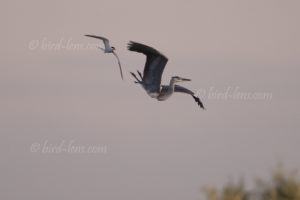 An image that could have come from a book about pterosaurs due to the monochrome background of a late afternoon sky. A larger winged animal is being chased by a tern against a pinkish-gray sky. The body posture or the cutout from a body turn seems almost artistic and unusual. Although, the background of the photo is just trivial. A Gray Heron (Ardea cinerea) had flown over a mixed colony of Black-headed Gulls (Larus ridibundus) and Common Terns (Sterna hirundo). As a large bird, the Gray Heron was immediately identified by the Common Tern as a potential breeding predator and approached. Since the Gray Heron flew steadfastly towards the breeding rafts of the gull colony and eventually crossed them, the attacks were intensified, mainly by the Common Terns. The aggressive attacks of the Common Terns were impressive, as they were on skin-better feather contact with the Gray Heron. When trying to escape the predicament, it was amazing to see what contortions a flying Gray Heron is capable of. How much the Gray Heron was afraid of the situation could also be seen from the high-pitched croaking calls that the Heron made loudly.
An image that could have come from a book about pterosaurs due to the monochrome background of a late afternoon sky. A larger winged animal is being chased by a tern against a pinkish-gray sky. The body posture or the cutout from a body turn seems almost artistic and unusual. Although, the background of the photo is just trivial. A Gray Heron (Ardea cinerea) had flown over a mixed colony of Black-headed Gulls (Larus ridibundus) and Common Terns (Sterna hirundo). As a large bird, the Gray Heron was immediately identified by the Common Tern as a potential breeding predator and approached. Since the Gray Heron flew steadfastly towards the breeding rafts of the gull colony and eventually crossed them, the attacks were intensified, mainly by the Common Terns. The aggressive attacks of the Common Terns were impressive, as they were on skin-better feather contact with the Gray Heron. When trying to escape the predicament, it was amazing to see what contortions a flying Gray Heron is capable of. How much the Gray Heron was afraid of the situation could also be seen from the high-pitched croaking calls that the Heron made loudly.
Of course, the comparison between the dislocating Gray Heron and a pterosaur is based on the fragments of science published with which we are familiar. Much of the way of life and flight abilities of the Pterosaurs are still completely unknown. It is generally assumed that especially the small species could actively fly very well. Until now, it was assumed that the large Pterosaurs – which also brought memories to life here – were gliders which, like birds of prey, were dependent on the updraft, or even, like the albatrosses, used horizontal winds of different speeds in wave troughs in order to fly with as little energy as possible. Others should fly over the ocean like pelicans or gulls and catch fish in flight from the water surface.
Recent research assumes that the really big, the gigantic Pterosaurs of the past, were probably more pedestrians than flying robbers. In one study, a certain type of pterosaur, called the Azhdarchid, was examined in more detail. These creatures were among the largest of all pterosaurs. Their wingspan reached more than ten meters. The Azhdarchids have been relatively well known since the 1970s, but how they lived is still a hot topic to this day. An evaluation of their anatomy and the environment in which the fossils were found now indicate that they were predominantly on an ongoing basis. The long legs and skulls of the animals would have been suitable for picking up smaller animals from the ground – similar to a White Stork (Ciconia ciconia) today. Other aspects of the Azhdarchid anatomy such as the relatively small, padded feet and the long but weak jaws fit well with the stalker hypothesis, but not with the other ways of life discussed. Whatever. The pterosaurs have long since died out; a Gray Heron under pressure in flight can still put astonishment on our faces.
In order to meet the growing demand for top images of the rarer species of Palaearctic Bird-lens.com has specifically made trips to remote places. Additionally every chance is used, if a rare bird is around the homeground. This to do everything to ensure excellent photos of the Birds of the Western Palearctic . The results in images also of rare Western Palaearctic birds is very good. There are other nice images of birds, that you will find behind the tab “Picture Shop“. Just give a notice if you need a picture of a bird which is not online.